Animals That Can Kill a Lion
The lion may be considered the king of the jungle, but that doesn’t mean that this predator is invincible. The African habitats that these big cats call home have bred a variety of dangerous creatures — and many of them are willing to take down a lion whether it’s in self-defense or as an act of territorial opportunity. Here are eight animals that have been known to kill a lion in the right situation.
#8: Giraffe — Long and Dangerous Legs

John Ceulemans/Shutterstock.com
Like most apex predators, lions tend to pick out the sickest and most vulnerable prey animals to target, a form of natural selection that keeps evolutionary trends pressing forward — but it’s a tactic that makes sense when you take into account the sheer weight and reach of a giraffe. The average male giraffe weighs comfortably more than 2000 pounds and reaches a height of seven feet before calculating their six-foot necks. That leaves them towering over the average 450 pounds and seven-foot-long lion. While giraffe calves are easy targets, adults offer a risk that’s as high as it is high reward. Because while a single corpse can feed a pride and their hovering scavengers for quite some time, a giraffe can kick with a force of 2,000 pounds per square inch. That’s enough to decapitate a lion who gets too close.
#7: Crocodile — Nightmares of the Nile
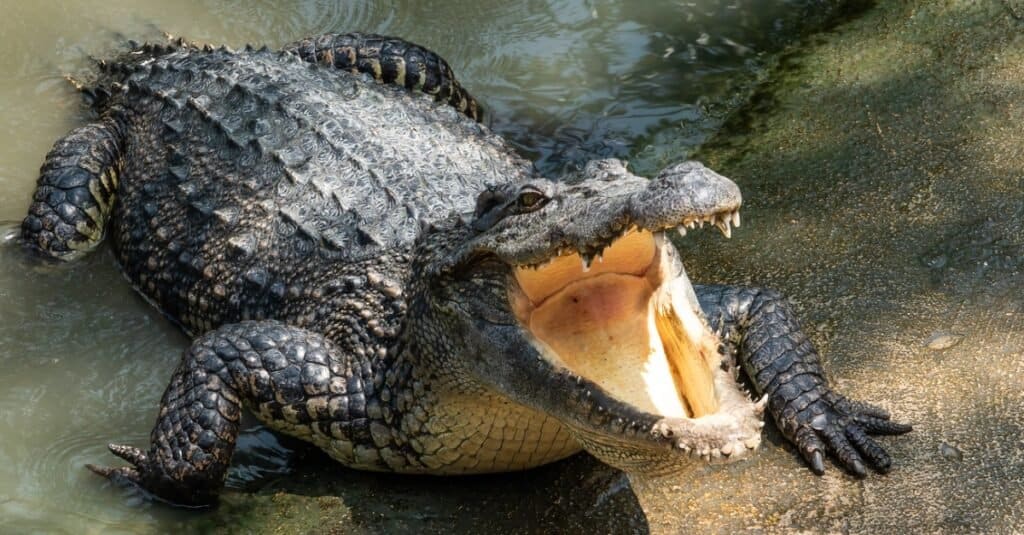
AppleZoomZoom/Shutterstock.com
Lions aren’t afraid to poach eggs from an alligator’s nest when opportunities are lean, but adults of the species can pose a real danger to lions. These species don’t normally intercede on one another, but large carcasses can draw them into territorial disputes — and crocodiles have been known to prey on lions that are caught lingering too deep in the watering hole. A crocodile has an average bite force of 3,700 pounds per square inch — a distinct step up from the 650 PSI bite force of a lion. These are battles where the environment is most likely to determine the outcome. The pack tactics of lions give them an advantage in numerous situations, but a crocodile’s tactic of latching onto a target and simply drowning them can be a very effective way for this animal to kill a lion when challenging lions out of their element.
#6: Rhinoceros — A Walking Tank
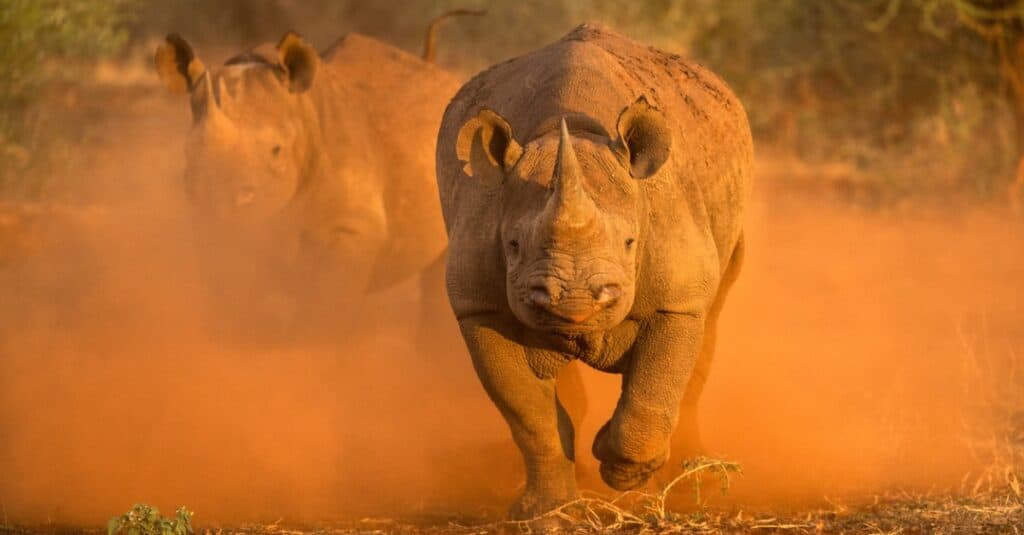
iStock.com/Udo Kieslich
Lions are known to selectively prey on the black rhinoceros — and those that are most selective are generally the lions that live the longest. While lions are known to hunt down rhino calves, attempts to take down fully grown rhinos are rare even when there’s an entire pride of lions at work. While they’re known to sometimes treat elephants as competition, rhinos generally keep to themselves — and they’re only inclined to attack when they’re feeling like they or their young or being threatened.
They may weigh roughly 4,500 pounds, but a full-grown rhino can reach a speed of 35 miles per hour, and its horn is capable of goring an adult lion. Most lions recognize that facing down an adult rhino is not worth the risk, but researchers warn that these attacks of opportunity will become more common as droughts and other weather conditions lead to greater scarcity.
#5: Porcupine — A Meal Most Painful
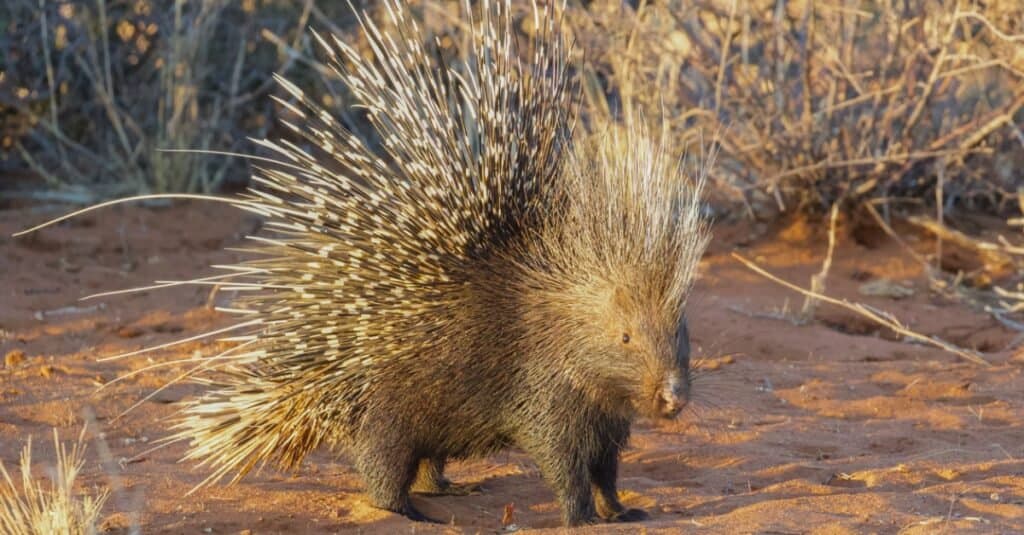
iStock.com/Pedro Ferreira do Amaral
While the quill-covered porcupine might not seem like an appetizing meal to us, there’s a lot of succulent meat there that can be tempting to predators like lions during lean seasons. Lions that live a long time tend to learn better than to sink their claws into porcupines early on — and it’s generally young males of the species that try and fail to hunt porcupines. This is a scenario where having friends can mean the difference between life or death.
Lions sometimes die from the quills without anyone to help them, and others are so injured by the attack that they have to resort to hunting easier prey. Defeat at the quills of porcupines and the injuries it brings will often force lions towards human communities for easy prey. Desperate conditions cause young males to hunt dangerous prey like porcupines, and the injuries they suffer push them to more dangerous measures.
#4: Hyena — Power in Numbers
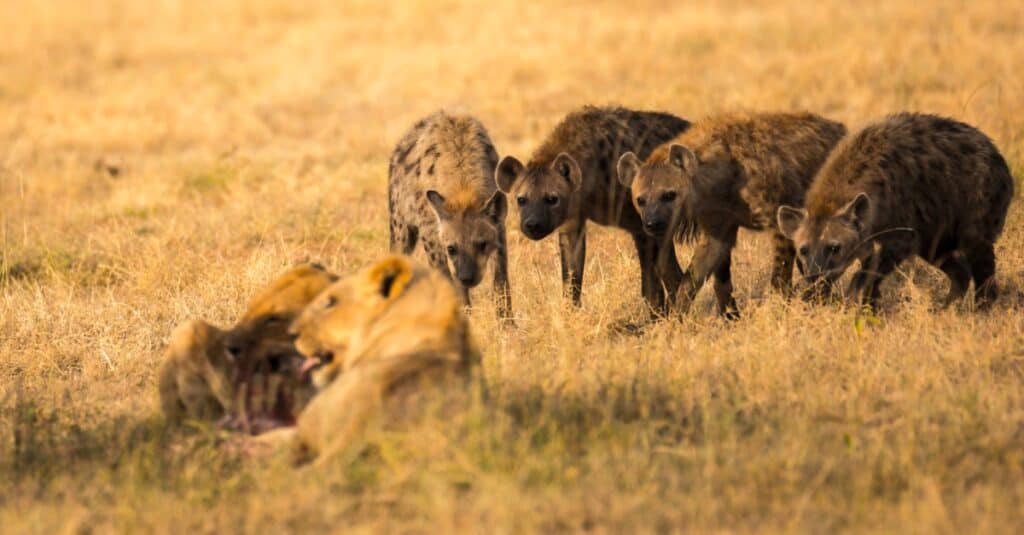
iStock.com/Staincliffe
Hyenas and lions have a lot in common, but their shared habits and habitats make them fierce adversaries. Hyenas are known for eating their prey alive to prevent their kill from getting poached by lions or other larger predators — and they’re also known to scavenge the kills of lions. Territorial disputes and conflicts over carcasses are common, and victory often comes down to sheer numbers.
Lions are more likely to steal kills from hyenas than the other way around, and, even though these animals can kill a lion, hyenas will generally admit defeat easily and settle to merely harass the lions who have taken over the carcass and steal bits of meat where they can. But in instances where hyenas outnumber lions six to one or where the threat takes the form of smaller lionesses and young males, hyenas have been known to go in for the kill with their sharp claws and bone-crunching teeth.
#3: Water Buffalo — Fighting as Family
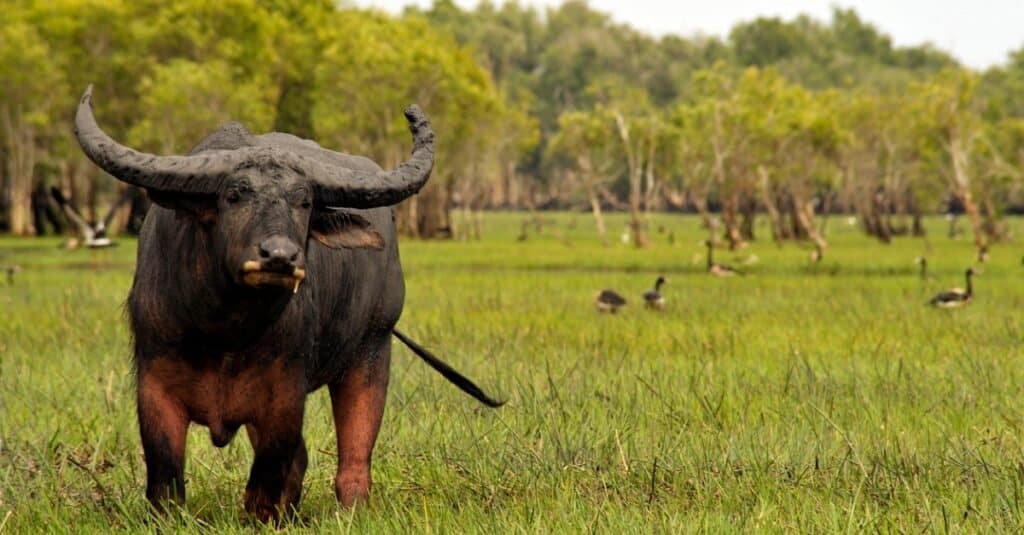
iStock.com/SvdM
Water buffalo aren’t the largest prey that lions are known to pursue, but that doesn’t make them any less deadly. Lions take advantage of the large herds that these animals travel in and strike from behind to avoid their brutally sharp horns. Lionesses will either take a buffalo by surprise or bring down the weakest and slowest when the herd flees — but those same herd tactics can be lethal to lions.
Many buffalo herds practice mobbing tactics which take advantage of their sheer numbers to chase off or even kill lions that dare attack them. Water buffalo pose a proactive threat as well, as these giant ungulates are known to seek out lion cubs and trample them to death before they can grow and pose a threat to the buffalo’s herd.
#2: Hippo — Jaws of Death
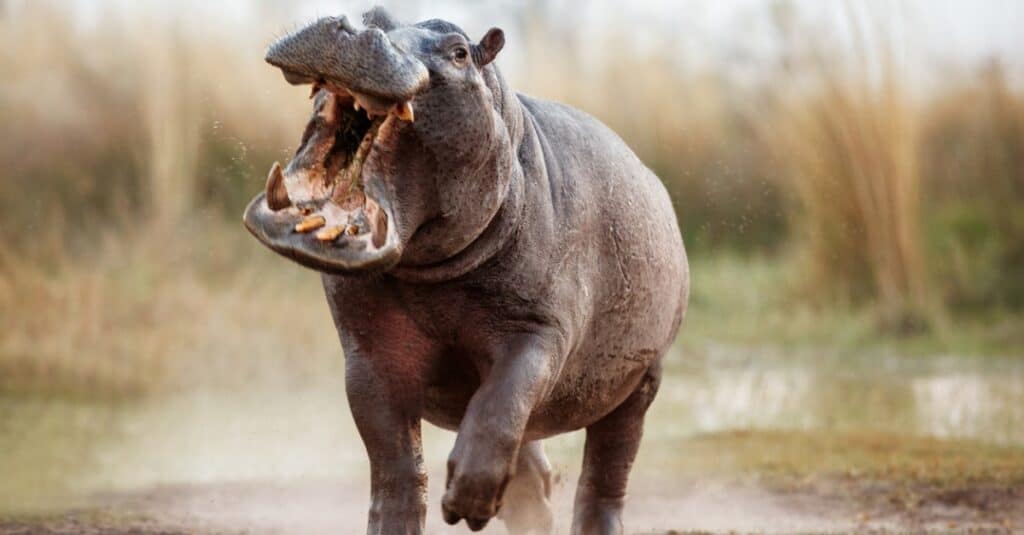
PhotocechCZ/Shutterstock.com
While they may just look like big, goofy pigs, hippos kill more humans a year than lions. Lions usually make a habit of respecting their territorial boundaries. Despite weighing over 3,000 pounds, these enormous mammals can reach top speeds of 35 miles per hour. Despite that, a lack of food sometimes leads lions to attack hippos — though this requires coordination on the part of a group of lions.
Thanks to the sheer size of the hippo and the thickness of their skin, even an organized lion pride will need to spend a lot of time wearing down their prey. By contrast, the 1800 PSI bite force of a hippo’s jaw — combined with their prominent teeth — can pulverize the body of a lion easily. One wrong move could mean defeat for the lion. Lions may also become a target of an angry hippo if they find themselves venturing into their watery territory.
#1: Elephant — Big Body and a Big Brain

David Steele/Shutterstock.com
The elephant is the largest land mammal, a characteristic that ensures a pride will need all lions on deck to have a chance of bringing one down with claws and teeth. It’s no surprise that these animals can kill a lion. That’s why lions mostly target elephant calves — and it’s why these social creatures have developed protective habits to keep their young safe.
A male elephant can reach an incredible weight of 14,000 pounds, and entire herds will circle up to physically shield their young against lions. The tusks and heavy hooves of an elephant are a formidable threat for even a group of lions, but they’ve also been known to pick up trunks as large as 400 pounds and swing them like weapons against attackers.
Lions can easily die when facing even a single grown elephant, and those who don’t might find themselves unable to survive with the injuries they’ve suffered. Age gives elephants more than a weight advantage too. Researchers have discovered that older elephants have developed more sophisticated methods for defending against lions and that they spread that knowledge to actively shield their herd against threats.
Next Up: Are Guinea Pigs Nocturnal?
More from A-Z Animals
The lion may be considered the king of the jungle, but that doesn’t mean that this predator is invincible. The African habitats that these big cats call home have bred a variety of dangerous creatures — and many of them are willing to take down a lion whether it’s in self-defense or as an act of territorial opportunity. Here are eight animals that have been known to kill a lion in the right situation.
#8: Giraffe — Long and Dangerous Legs

John Ceulemans/Shutterstock.com
Like most apex predators, lions tend to pick out the sickest and most vulnerable prey animals to target, a form of natural selection that keeps evolutionary trends pressing forward — but it’s a tactic that makes sense when you take into account the sheer weight and reach of a giraffe. The average male giraffe weighs comfortably more than 2000 pounds and reaches a height of seven feet before calculating their six-foot necks. That leaves them towering over the average 450 pounds and seven-foot-long lion. While giraffe calves are easy targets, adults offer a risk that’s as high as it is high reward. Because while a single corpse can feed a pride and their hovering scavengers for quite some time, a giraffe can kick with a force of 2,000 pounds per square inch. That’s enough to decapitate a lion who gets too close.
#7: Crocodile — Nightmares of the Nile

AppleZoomZoom/Shutterstock.com
Lions aren’t afraid to poach eggs from an alligator’s nest when opportunities are lean, but adults of the species can pose a real danger to lions. These species don’t normally intercede on one another, but large carcasses can draw them into territorial disputes — and crocodiles have been known to prey on lions that are caught lingering too deep in the watering hole. A crocodile has an average bite force of 3,700 pounds per square inch — a distinct step up from the 650 PSI bite force of a lion. These are battles where the environment is most likely to determine the outcome. The pack tactics of lions give them an advantage in numerous situations, but a crocodile’s tactic of latching onto a target and simply drowning them can be a very effective way for this animal to kill a lion when challenging lions out of their element.
#6: Rhinoceros — A Walking Tank

iStock.com/Udo Kieslich
Lions are known to selectively prey on the black rhinoceros — and those that are most selective are generally the lions that live the longest. While lions are known to hunt down rhino calves, attempts to take down fully grown rhinos are rare even when there’s an entire pride of lions at work. While they’re known to sometimes treat elephants as competition, rhinos generally keep to themselves — and they’re only inclined to attack when they’re feeling like they or their young or being threatened.
They may weigh roughly 4,500 pounds, but a full-grown rhino can reach a speed of 35 miles per hour, and its horn is capable of goring an adult lion. Most lions recognize that facing down an adult rhino is not worth the risk, but researchers warn that these attacks of opportunity will become more common as droughts and other weather conditions lead to greater scarcity.
#5: Porcupine — A Meal Most Painful

iStock.com/Pedro Ferreira do Amaral
While the quill-covered porcupine might not seem like an appetizing meal to us, there’s a lot of succulent meat there that can be tempting to predators like lions during lean seasons. Lions that live a long time tend to learn better than to sink their claws into porcupines early on — and it’s generally young males of the species that try and fail to hunt porcupines. This is a scenario where having friends can mean the difference between life or death.
Lions sometimes die from the quills without anyone to help them, and others are so injured by the attack that they have to resort to hunting easier prey. Defeat at the quills of porcupines and the injuries it brings will often force lions towards human communities for easy prey. Desperate conditions cause young males to hunt dangerous prey like porcupines, and the injuries they suffer push them to more dangerous measures.
#4: Hyena — Power in Numbers

iStock.com/Staincliffe
Hyenas and lions have a lot in common, but their shared habits and habitats make them fierce adversaries. Hyenas are known for eating their prey alive to prevent their kill from getting poached by lions or other larger predators — and they’re also known to scavenge the kills of lions. Territorial disputes and conflicts over carcasses are common, and victory often comes down to sheer numbers.
Lions are more likely to steal kills from hyenas than the other way around, and, even though these animals can kill a lion, hyenas will generally admit defeat easily and settle to merely harass the lions who have taken over the carcass and steal bits of meat where they can. But in instances where hyenas outnumber lions six to one or where the threat takes the form of smaller lionesses and young males, hyenas have been known to go in for the kill with their sharp claws and bone-crunching teeth.
#3: Water Buffalo — Fighting as Family

iStock.com/SvdM
Water buffalo aren’t the largest prey that lions are known to pursue, but that doesn’t make them any less deadly. Lions take advantage of the large herds that these animals travel in and strike from behind to avoid their brutally sharp horns. Lionesses will either take a buffalo by surprise or bring down the weakest and slowest when the herd flees — but those same herd tactics can be lethal to lions.
Many buffalo herds practice mobbing tactics which take advantage of their sheer numbers to chase off or even kill lions that dare attack them. Water buffalo pose a proactive threat as well, as these giant ungulates are known to seek out lion cubs and trample them to death before they can grow and pose a threat to the buffalo’s herd.
#2: Hippo — Jaws of Death

PhotocechCZ/Shutterstock.com
While they may just look like big, goofy pigs, hippos kill more humans a year than lions. Lions usually make a habit of respecting their territorial boundaries. Despite weighing over 3,000 pounds, these enormous mammals can reach top speeds of 35 miles per hour. Despite that, a lack of food sometimes leads lions to attack hippos — though this requires coordination on the part of a group of lions.
Thanks to the sheer size of the hippo and the thickness of their skin, even an organized lion pride will need to spend a lot of time wearing down their prey. By contrast, the 1800 PSI bite force of a hippo’s jaw — combined with their prominent teeth — can pulverize the body of a lion easily. One wrong move could mean defeat for the lion. Lions may also become a target of an angry hippo if they find themselves venturing into their watery territory.
#1: Elephant — Big Body and a Big Brain

David Steele/Shutterstock.com
The elephant is the largest land mammal, a characteristic that ensures a pride will need all lions on deck to have a chance of bringing one down with claws and teeth. It’s no surprise that these animals can kill a lion. That’s why lions mostly target elephant calves — and it’s why these social creatures have developed protective habits to keep their young safe.
A male elephant can reach an incredible weight of 14,000 pounds, and entire herds will circle up to physically shield their young against lions. The tusks and heavy hooves of an elephant are a formidable threat for even a group of lions, but they’ve also been known to pick up trunks as large as 400 pounds and swing them like weapons against attackers.
Lions can easily die when facing even a single grown elephant, and those who don’t might find themselves unable to survive with the injuries they’ve suffered. Age gives elephants more than a weight advantage too. Researchers have discovered that older elephants have developed more sophisticated methods for defending against lions and that they spread that knowledge to actively shield their herd against threats.
Next Up: Are Guinea Pigs Nocturnal?






